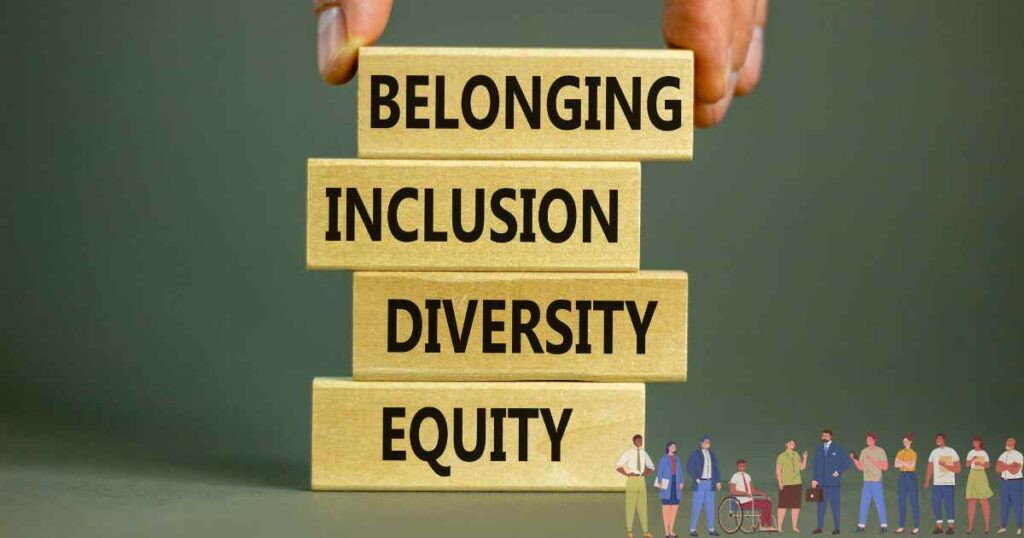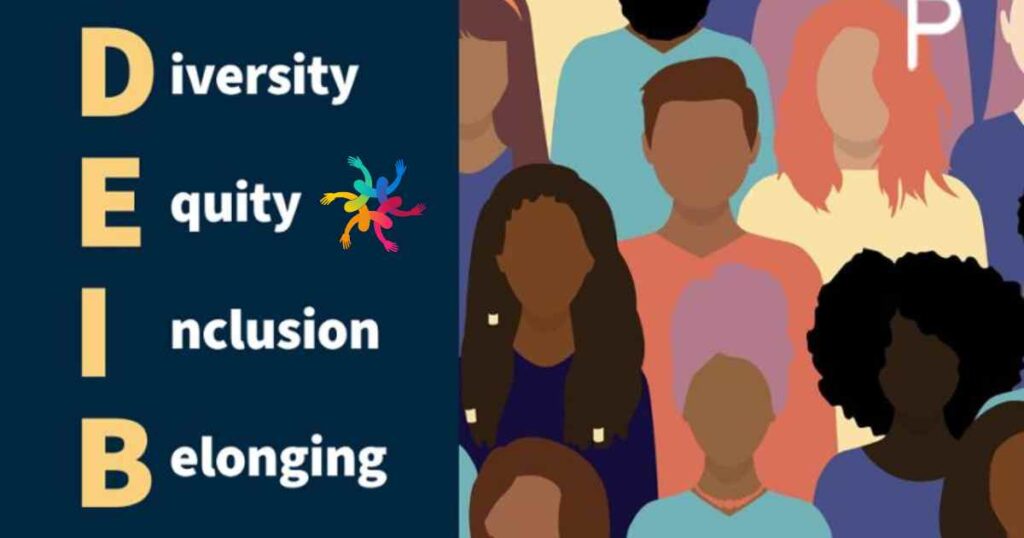In this day and age, companies can’t afford to overlook the importance of diversity, equity, inclusion and belonging (DEIB). Beyond being mere buzzwords that make catchy headlines, these principles are critical components in building a successful organization. It’s essential that businesses understand what DEIB entails and how they can implement it at every level of their operations to reap the benefits – both moral and financial.
DEIB Meaning

DEIB- an acronym for diversity, equity, inclusion and belonging; lies at the forefront of creating successful workplace cultures. These four concepts comprise distinct yet interconnected aspects that work in tandem to foster a healthy environment where every individual thrives. Thus, with companies paying more attention to their DEIB strategies, they commemorate a better workforce culture.
- Diversity refers to the presence of different identities, perspectives and experiences in a group or organization. Diversity can include aspects such as race, ethnicity, gender, sexual orientation, age, disability, religion, culture and more.
- Equity refers to the fair and respectful treatment of all people in a group or organization. Equity means ensuring that everyone has equal access to opportunities, resources and outcomes, regardless of their differences. Equity also means addressing and eliminating systemic barriers and biases that create disadvantages for some groups.
- Inclusion refers to the active involvement and participation of all people in a group or organization. Inclusion means creating a culture where everyone feels valued, respected and supported for who they are and what they contribute. Inclusion also means fostering a sense of belonging and connection among all members of the group or organization.
- Belonging refers to the emotional and psychological state of feeling accepted and appreciated by a group or organization. Belonging means having a sense of identity and purpose within the group or organization. Belonging also means feeling comfortable and confident to express oneself authentically and fully.
DEIB is not a one-time initiative or a checkbox to tick. It is an ongoing process that requires commitment, action and accountability from all levels of the organization.
How to put DEIB at the forefront of your organization

Putting DEIB at the forefront of your organization is not only the right thing to do, but also the smart thing to do. Research has shown that organizations that embrace DEIB have higher performance, innovation, customer satisfaction and employee engagement than those that do not.
Here are some steps you can take to put DEIB at the forefront of your organization:
- Start from the top: The leadership team should set the tone and direction for DEIB in the organization. They should communicate a clear vision and strategy for DEIB, align it with the organizational goals and values, and demonstrate their commitment through their actions and decisions.
- Assess your current state: The next step is to understand where you are now in terms of DEIB. You can conduct a DEIB audit or survey to measure the current level of diversity, equity, inclusion and belonging in your organization. You can also collect feedback from your employees, customers and stakeholders on their experiences and perceptions of DEIB in your organization.
- Identify your gaps and opportunities: Based on the assessment results, you can identify the areas where you need to improve or enhance your DEIB efforts. You can also identify the best practices and success stories that you can learn from or replicate in your organization.
- Create an action plan: The action plan should outline the specific goals, objectives, actions and indicators for your DEIB initiatives. The action plan should be realistic, measurable, achievable, relevant and time-bound. The action plan should also involve input and buy-in from all relevant stakeholders in your organization.
- Implement and monitor: The implementation phase is where you execute your action plan and monitor its progress and impact. You should assign roles and responsibilities for each action item, allocate resources and budget accordingly, provide training and support as needed, and track and report on the outcomes and outputs.
- Evaluate and improve: The evaluation phase is where you review your action plan’s effectiveness and efficiency. You should collect data and feedback on the results and impacts of your action plan, analyze them against your goals and objectives, identify what worked well and what didn’t work well, celebrate your achievements and learn from your challenges.
Why DEIB Is Important For Organizations

DEIB is not only a moral imperative, but also a strategic advantage for organizations. Here are some of the benefits of DEIB for organizations:
- Improved performance: Organizations that embrace DEIB can leverage the diverse talents, skills and perspectives of their employees to achieve better results and outcomes. DEIB can also enhance the decision-making, problem-solving and innovation capabilities of the organization by fostering a culture of collaboration, creativity and learning.
- Increased customer satisfaction: Organizations that embrace DEIB can better understand and serve the needs and preferences of their diverse customers and markets. DEIB can also help the organization to build trust, loyalty and reputation among its customers by demonstrating its social responsibility and commitment to diversity and inclusion.
- Enhanced employee engagement: Organizations that embrace DEIB can create a positive and inclusive work environment where employees feel valued, respected and supported. DEIB can also increase the motivation, productivity and retention of employees by providing them with opportunities for growth, development and recognition.
- Reduced risks and costs: Organizations that embrace DEIB can avoid or minimize the potential risks and costs associated with discrimination, harassment, lawsuits, turnover and reputational damage. DEIB can also help the organization to comply with the legal and regulatory requirements related to diversity and inclusion.
How to Promote DEIB in the Workplace

Promoting DEIB in the workplace is not a one-off event or a top-down mandate. It is a continuous and collaborative effort that requires the involvement and contribution of everyone in the organization. Here are some ways you can promote DEIB in your workplace:
- Educate yourself and others: The first step to promoting DEIB in the workplace is to educate yourself and others about the concepts, benefits and challenges of DEIB. You can attend training sessions, workshops, webinars or online courses on DEIB topics. You can also read books, articles, blogs or podcasts on DEIB issues and best practices. You can also share your knowledge and insights with your colleagues, managers and leaders.
- Speak up and listen: The second step to promoting DEIB in the workplace is to speak up and listen to others’ opinions and experiences on DEIB matters. You can initiate or join conversations, discussions or debates on DEIB topics. You can also provide feedback, suggestions or recommendations on how to improve or enhance DEIB in your workplace. You can also listen actively and empathetically to others’ stories, perspectives and concerns on DEIB issues.
- Take action and support: The third step to promoting DEIB in the workplace is to take action and support others’ actions on DEIB initiatives. You can participate in or lead projects, programs or events that promote or celebrate DEIB in your workplace. You can also volunteer for or donate to causes or organizations that advocate for or support DEIB in your community. You can also recognize or appreciate others’ efforts or achievements on DEIB matters.
Conclusion
DEIB is crucial for your organization because it can help you achieve higher performance, customer satisfaction, employee engagement and lower risks and costs. To put DEIB at the forefront of your organization, you need to start from the top, assess your current state, identify your gaps and opportunities, create an action plan, implement and monitor it, evaluate and improve it. To promote DEIB in your workplace, you need to educate yourself and others, speak up and listen, take action and support.
We hope this blog post has given you some useful information and tips on how to make your organization more diverse, equitable, inclusive and belonging. If you have any questions or comments on this topic, please feel free to contact us.
Thank you for reading! ?

